Энецкая традиционная одежда
Говоря о традиционной одежде энцев надо понимать, что история энецкого народа тесно переплетена с ненецкой и нганасанской в силу проживания на одной территории. Одежда тундровых энцев сходна с нганасанской, лесных – с ненецкой.
Исходным материалом для изготовления одежды были оленьи шкуры. Верхнюю и нижнюю одежду шили из шкур телят с очень густой и плотной шерстью. Для каждой части костюма использовали определенные участки шкуры с различной фактурой. Центральная часть шла на пошив верхней и нижней одежды; шкypa с ног оленя (камус) – на изготовление обуви и рукавиц; из так называемого копытного меха (щетки) получались прочные подошвы, а из шкурки с оленьих опей – детская обувь. Нитки делали из оленьих сухожилий прямо во время шитья. Швея клала рядом с собою пучок сухожилий, откуда по мере надобности отделяла волокна и сучила из них нитки на щеке правой ладонью. Чтобы они не раскручивались, женщина смачивала их слюной, пропуская между губами. Непременными атрибутами энецкого женского костюма были медные игольники – эйчэ погго, которые всегда пришивались парой на левой стороне комбинезона на уровне пояса. Ножницами энцы и нганасаны работать не умели и для работы использовали широкие ножи. При необходимости ими можно было укоротить ворс до нужной длины. Шкуру раскраивали на специальной кроильной доске и только со стороны мездры, чтобы не повредить ворс. Умелый подбор ворса делал места соединений двух деталей со стороны шерсти совершенно незаметными. Технология шитья и обработка материала была отработана веками. Энецкая девушка не могла выйти замуж, не научившись шить.
Комплекс мужской одежды энцев состоял из верхней и нижней плечевой одежды, натазников и обуви. Верхняя плечевая одежда носила название fagge (тундр.) pagge (лесн.). Это была глухая одежда с капюшоном, сшитая из шкурок короткошерстных пыжиков (шкур телят, убитых осенью) мехом наружу, длиной выше колен. Характерной особенностью ее покроя являлось отсутствие продольных боковых швов. В центре переда вшивали самостоятельно выкроенный кусок в форме нагрудника. Спинка сверху (кокетка) кроилась из одного куска вместе с затылочной и боковыми частями капюшона. Праздничная одежда отличалась большим количеством украшений. Швы прокладывали цветными кантиками из сукна, широко использовалась техника меховой мозаики. Видимо, в связи с пестротой и орнаментацией этой одежды энцы называли ее фадо фаггы (от фадабо – “рисовать, писать”).
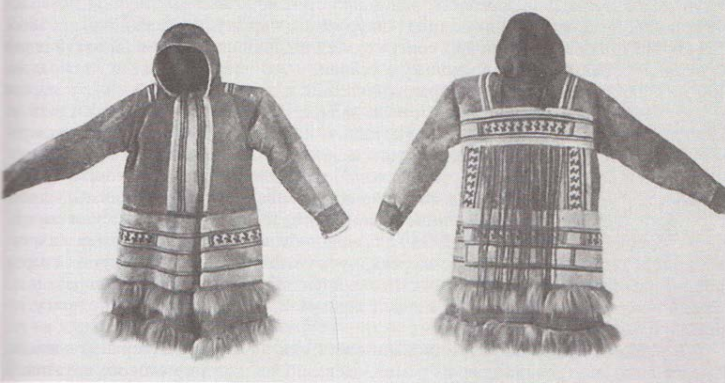
Нижнюю плечевую одежду (joddu) шили обычно из осенней шкуры дикого оленя, и она имела свой самостоятельный покрой. Стан ее состоял из шкуры, повернутой хвостовой частью вверх. В верхней ее части делали надрезы – проймы для вшивания рукавов с камусными рукавицами (obe). Подол одежды обшивали полоской белого пушистого собачьего меха, как и подол верха одежды, спереди он имел немного заостренный мыс. Длина этой одежды была ниже колена. Верхнюю и нижнюю плечевую одежду кое-где скрепляли по подолу. Зимняя меховая одежда, даже двойная, была недостаточно теплой при дальних поездках, поэтому поверх нее надевали “сокуй” (русское название), сшитый из зимних пушистых шкур оленя белого цвета мехом наружу. Сокуй из грубого меха энцы называли soku’ote, а из пыжика – nari, nadi. Характерным отличием этой одежды был султан на капюшоне, который назывался нока. Его делали из оленьего хвоста и пришивали к капюшону, для твердости иногда внутрь его зашивали гусиное перо.
Одеждой, имевшей производственное значение, были охотничьи сокуй, зимний и летний, которые шили из двух цельных шкур. М.Ф. Кривошапкин, характеризуя сокуй, используемый на промысле, описывает его как “…мешок, с местом для головы (капюшоном) из больших оленьих шкур мехом наружу…”. На капюшон охотничьих сокуев султан не пришивали. Зимний сокуй шили из пушистых белых шкур, поскольку в основном его носили на охоте со скрадом. Для того, чтобы не было шума при подползании к оленю, переднюю часть делали из мягких собачьих шкур. Летний сокуй, являвшийся защитой от дождя, т и л и ш оленьих шкур со стриженым мехом, т.е. шерсть на них подрезали до половины, причем делали это с помощью ножа; в таком виде шкуры не промокали.
Нижней поясной одеждой были натазники, короткие штаны, которые кроили из целого прямоугольного куска. Внутренние, нательные натазники – taruho – шили из ровдуги. Для наружных же – ниды – использовалась оленья шкура мехом внутрь Характерной особенностью энецких натазников было наличие продержки на нижних концах штанин. Кроме того, спереди, чуть ниже пояса за одну из своих сторон пришивался кусок ровдуги (10 х 14 см), окрашенный в красный цвет и нарезанный узкими продольными полосками в виде бахромы (djodo’o). Этот элемент присутствовал и на женских комбинезонах.
В энецкой традиции отсутствовали пояса для опоясывания верхней одежды. Имелся лишь внутренний пояс из ремня, одевавшийся поверх мехового натазники. К нему с помощью медных колец справа прикрепляли огниво, слева – нож в ножнах кожаный футляр с длинной железной трубкой. Нижние концы ножен и трубки пристегивались к ноге над коленом.
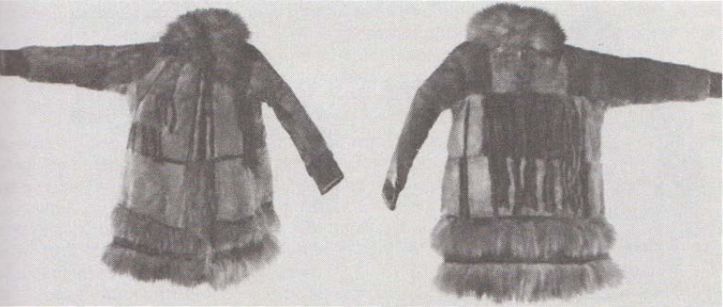
Мужская обувь различалась по сезонам. Зимняя носила название фэ (тундр.), пэ (лесн.). Обувь не имела подъема и представляла собой внешне как бы цилиндрический чехол. Подошву делали из оленьих лбов. Летнюю обувь tori (тундр.), todi (лесн.) шили из ровдуги. Длина мужских “бакарей” (адаптированное русское название) была выше колен. Верхний край ее голенищ срезали наискось. Спереди к ним пришивали ровдужные вязки, с помощью которых обувь привязывали к поясу; другую пару вязок пришивали под коленом, их завязывали вокруг ноги. Зимой “бакари” надевали поверх теплых чулок из тонкой оленьей шкуры lutu, сшитых мехом внутрь, причем покрой чулок полностью совпадал с покроем обуви. Летом обувь носили на босую ногу, в подошве делали отверстие, из которого вытекала попавшая внутрь вода.
Женская одежда, как и мужская, состояла из верхней и нижней плечевой одежды, нательной одежды, обуви и головных уборов. Нательной одеждой женщин был комбинезон: зимний делали из оленьей шкуры с подстриженным ворсом мехом внутрь (ниды); летний шили из ровдуги (таро – тундр., пии – лесн.). Зимой во время поездок женщины надевали меховой комбинезон поверх ровдужного, который представлял собой нижнюю одежду. Украшение его состояло из прямой вертикальной полосы шириной 5 см, нанесенной красной краской в центре нагрудной части, и мелких полосок, выполненных также краской на передних частях штанин; поверх окрашенных частей с помощью ровдужных ремешков прикрепляли 5-7 серповидных медных пластин с гравировкой. По сведениям Г.Н. Прокофьева, эти подвески на груди женщины носили название eruaddo (тундр.), pereso (лесн.). На передних частях штанин на ровдужных шнурках подвешивали семь трубчатых медных подвесок с кольцами и ажурными бляхами – tuo bine (тундр.), la ко bese (лесн.). Меховой и ровдужный комбинезоны имели пояс из ровдужной полоски niojo – тундр., nieijo – лесн.). На центральную часть пояса нашивали кусочек ровдуги с бахромой, окрашенный в красный цвет, аналогичный украшению, выполняемому на мужских натазниках. К комбинезону на уровне груди с двух сторон пришивали также два кольца для крепления огнива, крюка для чистки трубки, кисета для табака, а также игольницы.
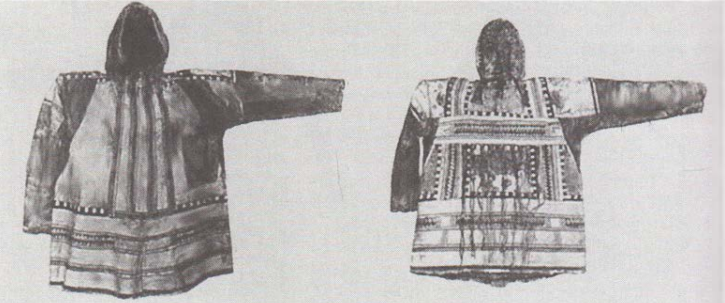
Поверх комбинезона летом или дома женщина надевала нижнюю плечевую одежду, сшитую мехом внутрь и носившую название комидо. Эта одежда по покрою полностью совпадала с нижней мужской плечевой одеждой. Единственное отличие – она была распашной. К ее круглому вороту пришивали воротник из собачьего или песцового хвоста (часто из отдельных кусков меха), который выправляли наружу на верхнюю одежду. К концам рукавов пришивали камусные рукавицы, оставляя незашитым место над ладонной частью. Подол покрывал только колени, к нему пришивали опушку из песцового меха.
Женскую верхнюю плечевую одежду энцы называли te’itifagge (тундр.). te’itepagge (лесн.). По материалу, форме и покрою она совпадала с верхней плечевой мужской одеждой, но была распашной, длиной выше колен. Обычно она служила верхом для зимней одежды, плотно пригонялась по нижней одежде и приметывалась к ней вдоль полок сверху донизу сухожильными нитками, швом в наметку. Одежда спереди завязывалась с помощью прикрепленных к полкам с изнанки ровдужных завязок, продетых в специальные отверстия наружу. При переездах, в дорогу, женщины поверх двойной зимней одежды надевали еще распашную одежду из длинношерстного меха, по своему назначению соответствовавшую мужскому дорожному “сокую”.
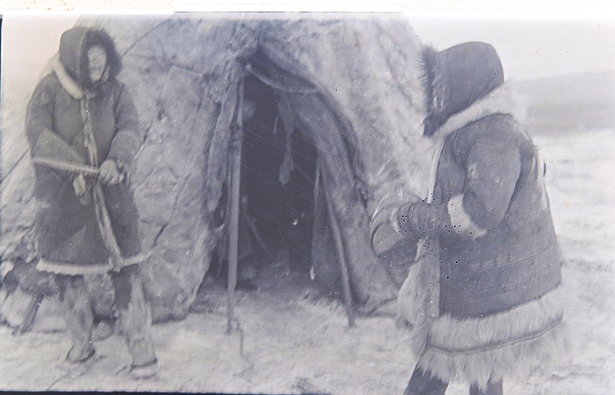
И у мужчин, и у женщин была погребальная и танцевальная одежда, по форме и крою не отличавшаяся от верхней плечевой одежды. Ее шили с достижением совершеннолетия для каждого юноши и девушки из красных, черных и белых сукон (отдельные части выделялись сукнами разных цветов). Суконный верх надевали на обычную меховую одежду. В отличие от повседневной, обрядовая одежда имела кожаный пояс, расшитый снаружи бисером, с прикрепленными по нижнему его краю медными литыми подвесками. Женская обувь (нэ фэ) была короче, чем мужская, верхние концы голенищ покрывались концами штанин комбинезона, продержка туго затягивалась под коленом.
Женским головным убором был капор, сшитый из оленьих шкурок; у лесных энцев он назывался soe, у тундровых – тади, таи. Нижний (или домашний) капор изготовлялся из белого пыжика (мехом внутрь), причем теменная и затылочная части кроились отдельно и затем сшивались. Со всех краев капор обшивали черной недлинной опушкой из собачьего меха. Из того же материала, но мехом наружу, изготовляли и верхний капор. Его опушку делали из длинного черного собачьего меха. Головной убор, входивший в состав танцевальной (погребальной) одежды, был несколько иным. Его шили для девочки, когда она достигала семилетнего возраста, и затем, вместе с ростом девочки, его неоднократно перешивали. В отличие от повседневного к нему пришивали особую широкую лицевую опушку из песцового меха. султан имел гусиное перо внутри. По нижнему краю капора (у шеи) также приживали меховую опушку, соединявшуюся с лицевой и спускавшуюся по сторонам головы в виде двух лопастей. Поверх этого капора приметывали суконный верх.
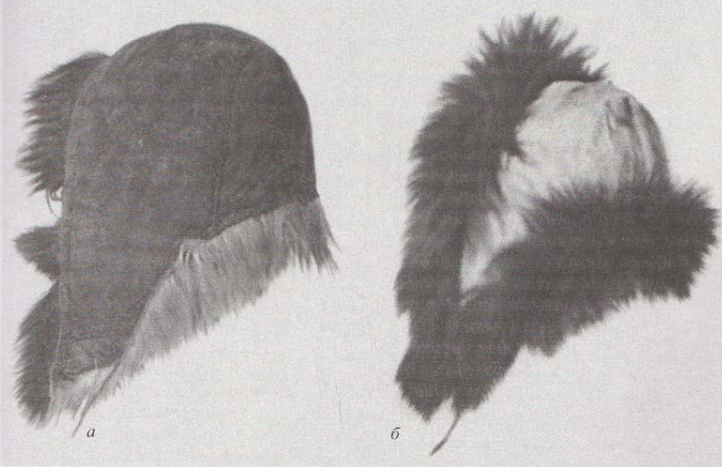
Для детей до пяти лет шили комбинезоны, по форме и крою напоминающие женские. Сзади в нижней части делали отверстие. Одежда детей более старшего возраста состояла из тех же элементов, что и взрослая. Своеобразной деталью детских малиц и парок являлось то, что к рукавам и груди пришивали маленькие колокольчики, перезвон которых, во-первых, позволял разыскивать малышей во время пурги; во-вторых, являлся защитой от злых духов, т.е. играл роль оберега. Детская обувь отличалась от взрослой: ее шили “по ноге”, т.е. она имела подъем.
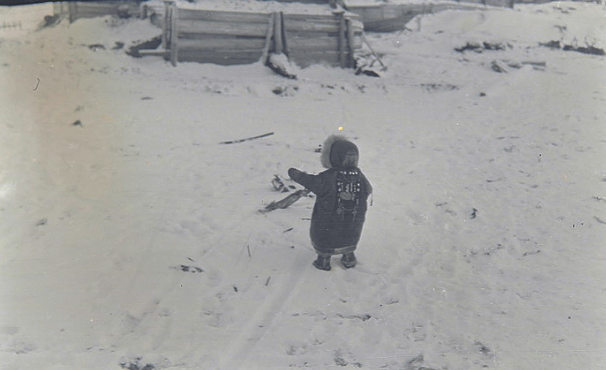
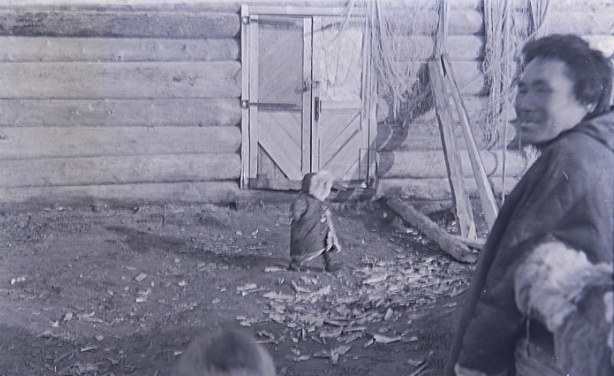
Лесные энцы, проживая в соседстве с лесными ненцами, довольно рано заимствовали не только ненецкий тип жилища, но и ненецкую одежду. Определить точное время заимствования не представляется возможным. В 1926 г. внешне она не отличалась от ненецкой. В связи с развитием в низовьях Енисея крупнотабунного оленеводства, которое в энецкой истории приходится на вторую половину XIX в., часть тундровых энцев также восприняла ненецкий костюм, который был наиболее приспособлен для ведения нового типа хозяйства (более длинная малица для долгих поездок на нарте). По данным Б.О. Долгих, в колхозе им. Кирова в 1926 г. 55% населения носили одежду энецко-нганасанского типа, 30% – ненецкого и 15% – долганского. Уже к 1948 г. соотношение изменилось: 71% взрослых мужчин и 68% женщин использовали ненецкую одежду и только 19% мужчин и 21% женщин в большей или меньшей степени сохранили энецкие формы костюма. К весне 1962 г., по свидетельству В.И. Васильева, энецкую мужскую одежду и обувь носил только один человек, а женский комплекс сохранился у нескольких энецких женщин. В то же время собственно ненецкий костюм у энцев в связи с этнической традицией был частично трансформирован: например, тундровые энцы обычно не надевают матерчатую накидку поверх малицы, кроме того их малица не имеет мехового подола. Но есть одна деталь энецкого комплекса одежды, которая не только продолжает бытовать в среде энецкого населения, но распространяется даже среди ненцев. Это женский капор.
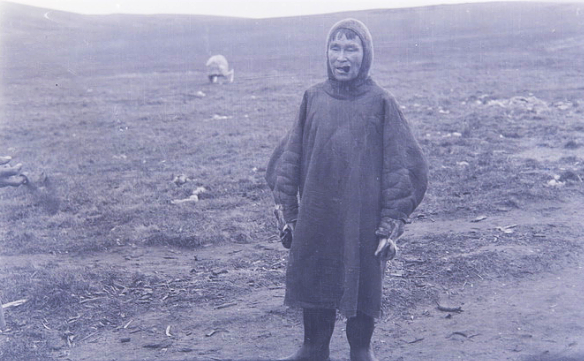
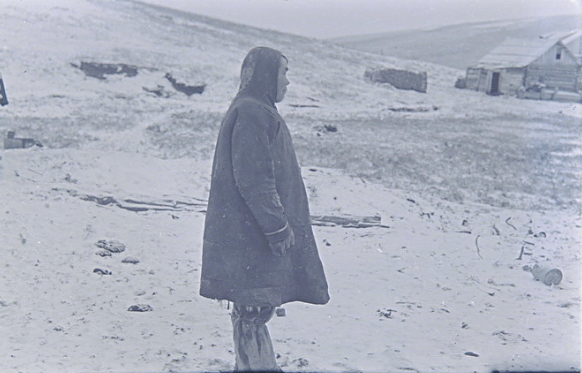
Нательная одежда (натазники у мужчин и комбинезоны у женщин) довольно рано, еще в начале XX в., стали выходить из употребления. Им на смену пришли русские рубахи и брюки темных цветов. При этом среди лесных энцев одежда, обувь и головные уборы русского типа появились раньше, чем у тундровых групп. В летнее время (особенно на рыболовном промысле) некоторые мужчины носили покупные штаны и рубахи, а из обуви среди рыбаков широкое распространение получили бродни. Во время Великой Отечественной войны в связи с нехваткой тканей и недостаточным завозом готовой одежды население вновь обратилось к традиционным типам костюма. В 1950-1960-х годы в весенне-летней одежде часто сочетались традиционные и покупные формы: готовый костюм с ровдужной обувью или платье традиционного покроя с покупными туфлями. Однако зимняя и промысловая одежда оставалась преимущественно традиционной, особенно у тундровых энцев. Процесс ее полного вытеснения начался уже е 1970-1980-х годах. Так, сокуи в поселках носят, как правило, только представители старшего поколения. Детская зимняя одежда шьется из традиционных материалов, сохраняет традиционный покрой, однако дети школьного возраста и молодежь носят русскую одежду и обувь.
В XX в. происходит формирование единых комплексов одежды и обуви, в частности, самодийского комплекса (малица, сокуй, меховые сапоги и чулки), включающего элементы ненецкого, коми-зырянского, возможно угорского комплексов.
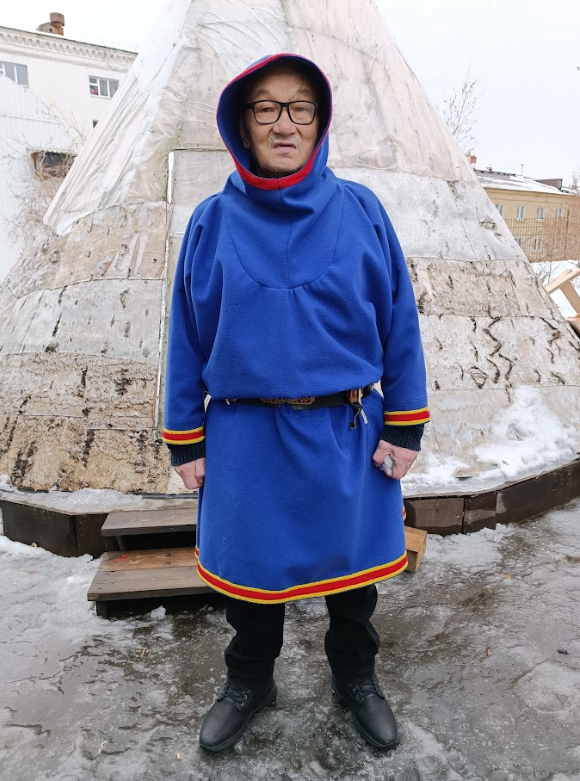
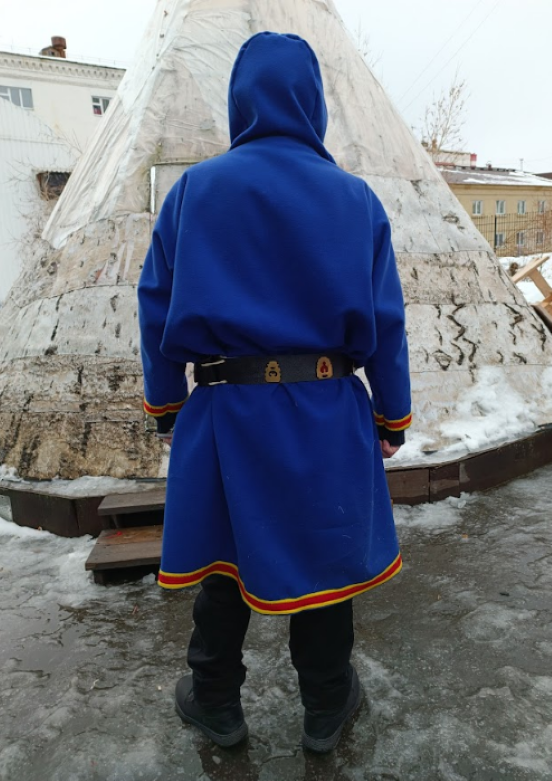
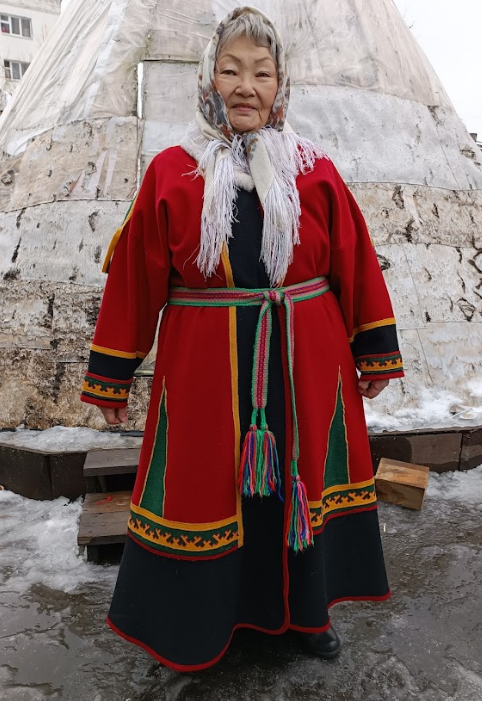
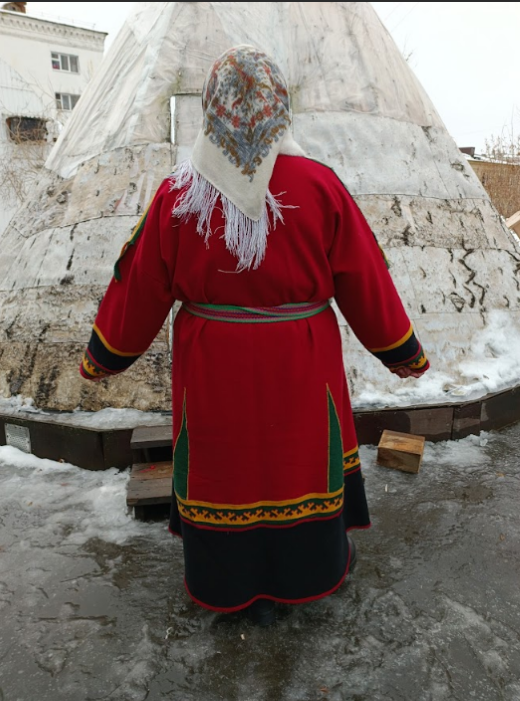
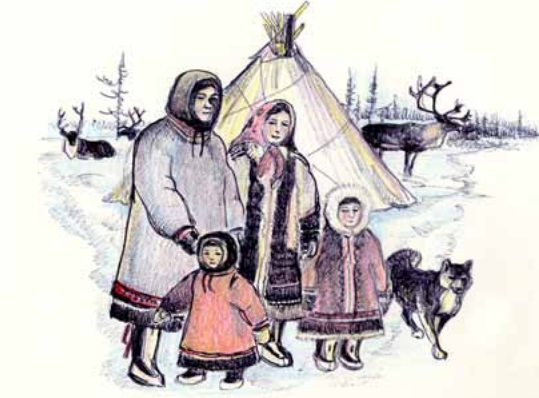
Literature
- Болина З.Н. Эззууй – След нарты. – Дудинка, 2014. – 155 с.: ил. Ссылка: https://www.tdnt.org/pdf_poli.php?id=25&t=publ
- Бытовые рассказы энцев [Со слов Р.А. Силкина] / Записи, введ. и коммент. Б.О. Долгих. М., 1962 (ТИЭ. Н.с. Т. 75)
- Васильев В.И. Ненцы и энцы Таймырского Национального округа // Преобразования в хозяйстве и культуре у народов Севера. М., 1970а. С. 106-164.
- Долгих Б.О. Очерки по этнической истории ненцев и энцев. М., 19706.
- Долгих Б.О. Колхоз им. Кирова Таймырского Национального округа // СЭ. М., 1949а. № 4. С. 75-93.
- Кривошапкин М.Ф. Енисейский округ и его жизнь. СПб., 1865. Т. 1, 2.
- Мифологические сказки и исторические предания энцев / Записи, введ. и коммент. Б.О. Долгих // ТИЭ. Н.с. М., 1961. Т. 66.
- Народы Западной Сибири : Ханты. Манси. Селькупы. Ненцы. Энцы. Нганасаны. Кеты / отв. ред. И.Н. Гемуев), В.И. Молодин, З.П. Соколова ; Ин-т этнологии и антропологии им. Н.Н. Миклухо-Маклая РАН ; Ин-т археологии и этнографии СО РАН. — М.: Наука, 2005. — 805 с. — (Народы и культуры). — ISBN 5-02-010297-0 (в пер.). – С. 540.
- Прокофьев Г.Н. Энецкий диалект // ЯПНС. М.; Л., 19376. С. 75-90.
- Этническое развитие народностей Севера в советский период. М., 1987.



